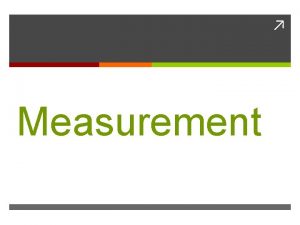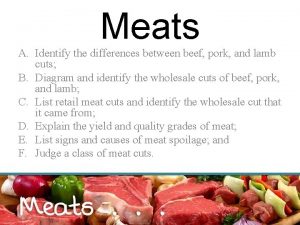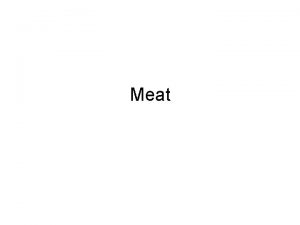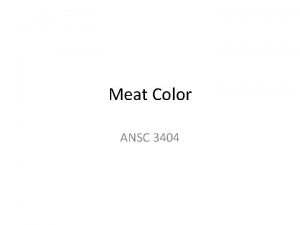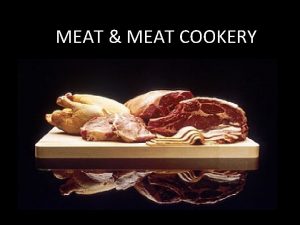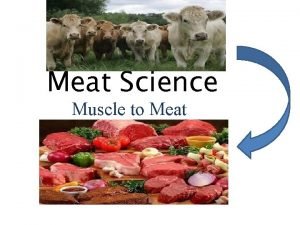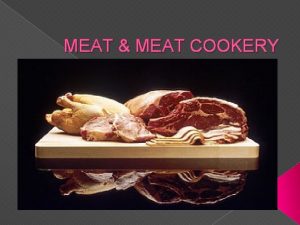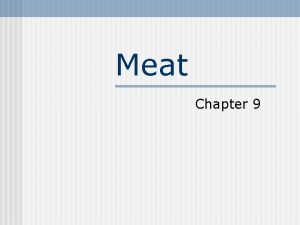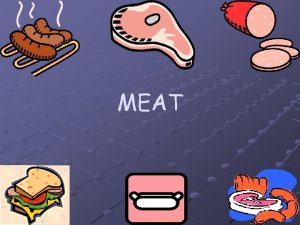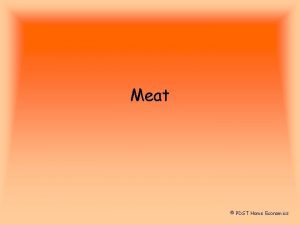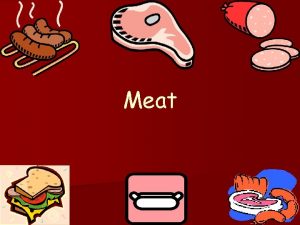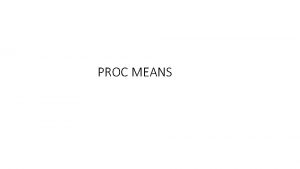MEAT QUALITY What Meat Quality Means Types of














- Slides: 14

MEAT QUALITY

What Meat Quality Means Types of quality Two overall types of quality can be distinguished. Functional quality refers to desirable attributes in a product. For example, we might want red meat to be tender and chicken to have good flavour. Conformance quality is producing a product that meets the consumer’s specification exactly. An example of this type of quality might be that we want pork chops to be trimmed so there is exactly 5 mm of fat overlying the lean, or we want ‘portion sized’ chicken breasts to weigh exactly a certain amount. When most people talk about quality they tend to mean functional quality, but quality management often focuses on conformance quality. However, both types are important. No one really wants chicken breasts that are exactly the right weight but have poor flavour or texture.

Different people mean different things when they talk of functional quality depending on their cultural background, personal experience and where they stand in the production chain; whether farmer, processor, retailer or consumer. In other words, quality has a number of different components. While certain of these are of interest to everyone, others are only immediately important to some sectors. Meat yield mainly concerns the farmer and wholesaler, technological characteristics mainly the processor and palatability – what the meat is like to eat – the final consumer.

Variation with time Concepts of quality vary over time. The main purpose of rearing pigs was originally less for their lean meat and more for the lard they produced. Pigs were selected to grow large and fat because this produced most lard. In the early North American meat industry, instead of curing the pork, meat packers would often collect the fat, rather as used to be done with whale’s blubber, by ‘trying’ it – heating the butchered carcasses in large vats or kettles to melt the fat which floated on the surface and could be ladled off. In contrast, modern North American and European pigs are relatively very lean, having been selected over the years to have less and less fat and proportionally larger muscles. At different times the highest quality has therefore been associated with both the fattest and the leanest pigs.

The major components of quality Yield and gross composition: Quantity of saleable product Ratio of fat to lean Muscle size and shape Appearance and technological characteristics Fat texture and colour Amount of marbling in lean (intramuscular fat) Colour and WHC of lean Chemical composition of lean Palatability: Texture and tenderness Juiciness Flavour Wholesomeness: Nutritional quality Chemical safety Microbiological safety Ethical quality: Acceptable husbandry of animals

Yield and composition The yield of product is important because it determines how much you have to sell. Higher yields mean more product and potentially greater profit. In meat terms this could mean a higher proportion of carcass relative to the weight of the live animal (a higher killing-out percentage) or a higher yield of saleable lean and fat to non-saleable wastebone. As well as the absolute yield of lean and fat, the relative amount of lean is important.

Appearance and technological characteristics Appearance of the lean and its technological characteristics are often related. This is because factors that influence the microstructure of the muscle post mortem affect both aspects of colour and also waterholding capacity (WHC). Colour is a major determinant of appearance and WHC of technological value. Appearance is important because it is practically the only criterion the consumer can use to judge the acceptability of most meat at purchase. This presupposes that spoilage has not resulted in an unpleasant odour as it can in fish that is not fresh. Unlike, for example, many fruits, where the firmness or texture of the raw product is a good index of ripeness, the texture of raw meat usually tells little or nothing about that of the cooked material The lean has a characteristic colour appropriate for each species and muscle but in general it should be bright in colour, and red or pink rather than brown, purple or grey. Moreover this colour should be stable to give the product a long shelf life.

There are three main reasons why waterholding capacity is important. First, the drip or exudate that results from poor WHC detracts from the appearance of the meat. This is especially so in modern retail packs where drip tends to collect, rather than draining away, and despite the frequent inclusion of absorbent pads in the bottom of trays to soak up the liquid. Second, loss of drip leads to weight loss in fresh meat, and in processed meats poor WHC may reduce water retention and therefore yield of product. Third, WHC is thought to influence the perceived juiciness of fresh meat after cooking. Meat with low WHC loses a lot of fluid in cooking and may taste dry and lack succulence. Problems with the colour and WHC of the lean are exemplified by the extreme conditions referred to as PSE (pale, soft, exudative) and DFD (dark, firm, dry) meat and which will be described later. The chemical composition of the lean, in particular its protein content may be important in determining the yield and quality of processed products.

The colour and chemical composition of the fat associated with the lean are important. Generally, the preference is for white or very pale pink fat over yellow pigmentation although the latter is accepted in certain cattle such as the Channel Island breeds, for example the Jersey. The yellow colour is caused by carotenes derived from green plants. It is therefore commoner in older animals and those that are grass-fed. The pigments are fat-soluble and the propensity to lay them down in the fat is genetically determined. Normally, firm fat is preferred over softer, oilier unsaturated fat. Soft fat may in fact be a problem in some modern very lean pigs but is beneficial in the Spanish breed of pig used to make Iberian hams. The pigs are fed on acorns from the locally grown cork oak trees and the pigs’ fat is therefore unsaturated and soft. In the preparation of the hams this is taken advantage of, the subcutaneous fat covering being carefully smoothed over the ham surface. The fat characteristics may also contribute to the desirable distinctive flavour of the product.

Palatability • Palatability or eating quality encompasses three main characteristics. • These are texture, juiciness and flavour/odour and, at least in red and poultry meats, their importance is usually in this order. • In many developed countries, people prefer their meat to be tender and the value of different cuts or joints reflects this.

The extremes of juiciness are dryness and succulence. Modern meat is occasionally criticized for its lack of succulence and this is attributed to either poor WHC or low levels of intramuscular or marbling fat. Intramuscular fat has tended to be reduced with the selection of animals for overall greater carcass leanness, particularly in pigs. The human perceptions of tenderness and juiciness appear to be interrelated. Juicy meat may be perceived as more tender than a similar sample which has inherently the same texture (for example, as measured by an instrumental shear test) but is less juicy.

Wholesomeness The wholesomeness of meat has two components. First, meat should be safe to eat, both in terms of freedom from parasites that may also infect humans, and microbiological pathogens and hazardous chemicals. People do not want to get food poisoning from eating meat. Neither do they want to be exposed to high levels of residues from previous veterinary medication of the animal, or from growthpromoting agents, or from adventitious contaminants such as pesticides.

Second, as well as this, people would prefer that meat was positively beneficial to their health in contributing minerals, vitamins and high value protein, and possibly essential fatty acids, such as eicosapentaenoic (EPA) and docosahexaenoic (DHA) acids (see Chapter 3), to their diet. The value of meat as a concentrated source of protein and energy is illustrated in Table 6. 2. Only dried seeds like lentils have comparable protein contents, and only lentils or grains like rice are more concentrated sources of energy (because of their high carbohydrate contents). However, it should be remembered that the energy value of meat will vary somewhat with variation in its fat content.

Ethical quality • The last major component of meat quality, ethical quality, might be disputed by some. However, there is concern amongst many people that meat should come from animals which have been bred, reared, handled and slaughtered in ways that promote their welfare and in systems which are sustainable and environmentally friendly
 What market forms of meat that is recently slaughtered
What market forms of meat that is recently slaughtered Poly and gon
Poly and gon Morphe means in metamorphism
Morphe means in metamorphism Meta means change and morph means heat
Meta means change and morph means heat Bio means life
Bio means life Bio means life logy means
Bio means life logy means Lamb and beef difference
Lamb and beef difference What is quality means
What is quality means Perform quality assurance
Perform quality assurance Quality management pmp
Quality management pmp What are quality standards in project management
What are quality standards in project management Ana quality assurance model
Ana quality assurance model Compliance vs quality
Compliance vs quality Quality control basics
Quality control basics Quality definition by quality gurus
Quality definition by quality gurus





